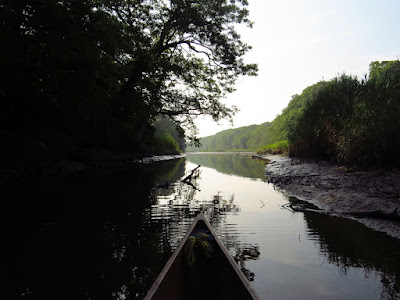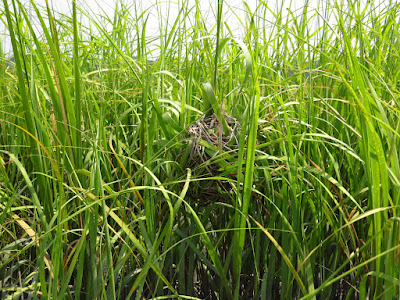I put in on the Pawcatuck. It is calm and 70F with clear skies, and nothing about that should change other than the temperature, which will rise to the mid 80's.
One person is at the launch site and he is fishing. I put the canoe in the water and turn upstream. In five minutes of paddling, I pass under a railroad bridge. At this point the river turns away from the road and heads out into the Great Swamp. It gets quiet pretty quickly.
The water is lower than usual for most of my trips here. It is probably only a matter of a half foot or so, but the difference causes some narrow patches of silty-sand to be exposed. On most of my trips here, the water runs right into the shoreline shrubs. There is almost no current, only the lean of submerged water plants suggests the flow.Just below Burdickville, I spot a mink running on the right bank. I get my camera ready, and although I miss the fully exposed running photo, I know that the mink will give me another chance. I have never seen a mink that could resist coming back to take a second or third look.
I make the awkward portage of the Burdickville dam ruins. It is always awkward, no matter what the water level is, but it is only 30 feet. There is more current above Burdickville and it slowly picks up pace the farther upriver I get. The river bottom becomes cobbles, boulders and gravel. It's ice age stuff - all rounded from being tumbled under the ice. The pitch pines start to show in force as well. Below the dam ruins, it was mostly oaks and swamp maples. Above, there are glacial sand deposits and dunes that pitch pines like to grow in. This part of the river has a lot of downed timber in the water to maneuver around. The game warden types do some clearing, but they keep it to a minimum as the downed wood is good for fish.I spot the first Osprey of the day. It has been a very quiet day for birds with just a couple Cormorants, this Osprey, and 2 Great Blue Herons. But, this is a narrow river running through a very wide swamp with a lot of good habitat - everything does not need to be on the river.I turn back as the Kings Factory Bridge comes into view. The water is shallow and fast at this point and I would have to wade to get higher. As it is, I am about 7 miles out and feel totally deep soaked in the surroundings.
I take out after 14 miles and 4-1/2 hours of paddling. I saw no one else other than two people fishing from the Burdickville bridge.




















